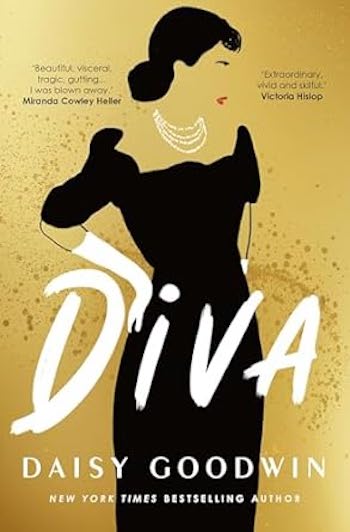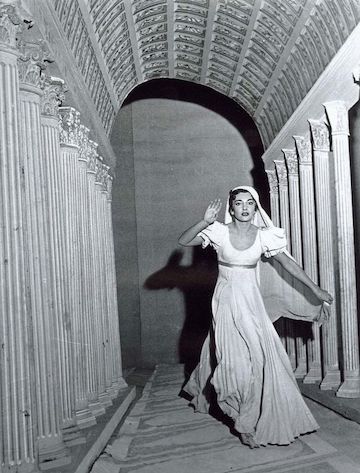Diva is the latest foray into fiction by the screenwriter and TV produce Daisy Goodwin. As with her three previous books it is either inspired by or based on the life of a real person, always an independent and successful woman. Her first novel, The American Heiress, was inspired by Consuelo Vanderbilt who married a cousin of Winston Churchill. Her next, The Fortune Hunter, had Elizabeth (Sisi) the Empress of Austria at its heart. This was followed by Goodwin’s most well-known book, Victoria, based on the life of the young queen, which became the basis of the successful TV series.
 With Diva, Goodwin has turned to the life of Maria Callas, the great opera singer, the centenary of whose birth was 2ndDecember 2023. In doing so, Goodwin has entered dangerous territory as for those who love opera, Callas is not just an iconic figure but La Divina whose combination of technical virtuosity, stage presence and emotional power was unique. Others have matched her technical virtuosity and purity of tone, but none have matched her acting ability and magnetism on stage. Goodwin largely gets away with it as she makes clear that she is not attempting an assessment of Callas as a singer but a fictionalised account that brings her humanity, and especially her tormented soul, to life. The well drawn picture that results is one full of drama, colourful personalities and high society gossip but with an eventually broken love affair at its heart.
With Diva, Goodwin has turned to the life of Maria Callas, the great opera singer, the centenary of whose birth was 2ndDecember 2023. In doing so, Goodwin has entered dangerous territory as for those who love opera, Callas is not just an iconic figure but La Divina whose combination of technical virtuosity, stage presence and emotional power was unique. Others have matched her technical virtuosity and purity of tone, but none have matched her acting ability and magnetism on stage. Goodwin largely gets away with it as she makes clear that she is not attempting an assessment of Callas as a singer but a fictionalised account that brings her humanity, and especially her tormented soul, to life. The well drawn picture that results is one full of drama, colourful personalities and high society gossip but with an eventually broken love affair at its heart.
Where Goodwin is particularly successful is in illustrating that the Callas of the voice and public personality, a woman driven, whose life was mostly a series of performances, was different to the vulnerable private person that was Maria. As Callas put it herself: “I would like to be Maria, but there is La Callas who demands that I carry myself with her dignity”.It helps explain why she never really recovered from being abandoned by Onassis in favour of Jackie Kennedy, the widow of JFK. Her relationship with Onassis was the only time she allowed even a little space for the emotional needs of Maria to be satisfied, let alone be seen in public. Onassis’ courtship had been long and had led her to believe he was serious but despite a relationship that lasted the best part of a decade he still deserted her. It was her only real relationship as in her marriage to Battista Meneghini, thirty years older than her, he was more like a fatherly manager than a husband.

Maria Callas as Giulia in “La Vestale”, by Gaspare Spontini, 1954
For all the torments of her private life Callas was strong willed and deeply committed to her art. It all resulted in her getting a reputation for being difficult when not getting her way. Goodwin illustrates this well when she describes how she fell out with Rudolph Bing the manager of the Met in New York and when, concerned about her voice, she refused to complete a performance at La Scala even though the President of Italy was in attendance. Her response to criticism of her actions was to say that “I will always be as difficult as necessary to achieve the best.” She could be difficult where her voice was concerned, but she was certainly not without courage. On one occasion, mentioned briefly by Goodwin, when she was being hissed by some in the audience she stopped singing, advanced to the front of the stage, told them that if they did not like her singing, they should leave. There was a stunned silence and she then continued with her performance.
What this book also does is underline the dramatic change that has taken place in celebrity culture since the 1950s and early 1960s. Callas was feted wherever she went, was paid court to by politicians and royalty, was often on the cover of magazines and the front page of newspapers, was the frequent subject of gossip columnists, was pursued by the paparazzi and sang to full houses where ever she performed. No opera singer today receives the press coverage and adulation that Callas received let alone fill Wembley Stadium for eight nights like Taylor Swift. Not that even Callas could have done the latter.
One of the strengths of Diva is that Goodwin makes good use of the fact that Callas was eminently quotable and certainly not without self-awareness and wit. The quotes also expose both her commitment to and understanding of her art as well as her loneliness: she once said that she only felt loved when she sang. What emerges from the story that Goodwin tells, fictionalised though it may be, is not just the personal tragedy behind the professional success but also the competitive and frequently cruel world of the arts and the social milieu that surrounds them.
For anyone not already a fan of Maria Callas but inspired by this readable book to find out more about Callas and especially to listen to her sing, there are recordings aplenty. If I had to recommend two, albeit somewhat nervously, they would be the 1953 EMI recording of Tosca and the 1954 Warner recording of Norma. To hear Callas talking about her art I would suggest her 1968 interview with Lord Harewood. It can be found here.
Diva by Daisy Goodwin is out now in hardback, published by Head of Zeus. For more information, please visit www.bloomsbury.com.




